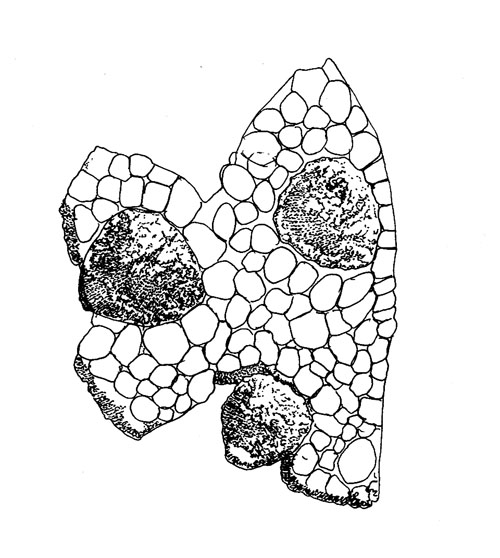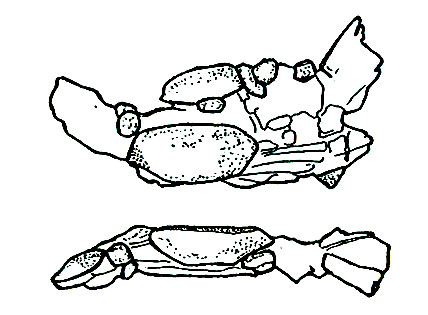Species: foxii HULKE, 1881
Etymology:
= Hylaeosaurus foxii (HULKE, 1881) COOMBS,
1971
= Euacanthus vectianus (A. TENNYSON) H. TENNYSON, 1897 (nomen
nudum)
Note: The first name of Polacanthus?
= Polanthus foxii NAISH & MARTILL,
2001 (sic)
Holotype: NHMUK (old BMNH) R175
Locality: Barnes High, West of Cowleaze Chine, Atherfield, (NGR SZ 443 806), Isle of Wight County, England, Southern United Kingdom.
Horizon: Wessex Formation, Wealden Group, Upper Wealden Marls.
Biostratigraphy:
Age: Valanginian-Hauterivian Stage, Neocomian Subepoch- Barremian Stage, Lower Gallic Subepoch, Early Cretaceous Epoch, Early Cretaceous.
Material: A partial skeleton with parts of 5 free dorsal vertebrae, complete synscrum composed of 11 fused elements, 5 dorsosacrals, 4 sacrals and 2 sacrocaudals, 22 free caudals, ossified tendons, 11 fragmentary dorsal ribs, 2 haemal arches, almost complete pelvic girdle including ilia, ischia and pubes, both left and right femora, left tibia ‘with co-ossified astragalus), distal end of left fibula, 2 metatarsals, an ungual phalanx, dermal armor including 7 presacral spines, a right sacral shield, 16 caudal plates, numerous keeled scutes and small ossicles.

Fragment of pelvic armor.

Mid tail section after Carpenter, et a;, 1999.
Note: The following is a break down of the above as per LYDEKKER, 1888
NHMUK (old BMNH) R175: An imperfect cervical vertebra.
NHMUK (old BMNH) R175a: An anterior dorsal vertebra.
NHMUK (old BMNH) R175b: 4 anterior dorsal vertebrae.
NHMUK (old BMNH) R175c: An anterior caudal vertebra.
NHMUK (old BMNH) R175d: 7 anterior caudal vertebrae.
NHMUK (old BMNH) R175e: A posterior caudal vertebrae.
NHMUK (old BMNH) R175f: 3 separate and 2 united posterior caudal vertebrae.
NHMUK (old BMNH) R175g: The extremity of the tail, showing dermal scutes and ossified tendons.
NHMUK (old BMNH) R175h: A chevron with another attached bone.
NHMUK (old BMNH) R175i: Proximal portion of a rib.
NHMUK (old BMNH) R175j: 4 specimens of the proximal portions of ribs.
NHMUK (old BMNH) R175k: The sacrum and lumbar dermal buckler, together with a cast of the upper surface of the latter.
NHMUK (old BMNH) R175l: Right femur.
NHMUK (old BMNH) R175m: Left femur.
NHMUK (old BMNH) R175n: Left tibia.
NHMUK (old BMNH) R175o: 2 metatarsals.
NHMUK (old BMNH) R175p: A series of flat, irregular dermal scutes.
NHMUK (old BMNH) R175q: A pair of angulated symmetrical scutes.
NHMUK (old BMNH) R175r: A larger pair of similar scutes.
NHMUK (old BMNH) R175s: A dermal scute bearing a short spine.
NHMUK (old BMNH) R175t: 3 short dermal spines.
NHMUK (old BMNH) R175u: A somewhat similar spine.
NHMUK (old BMNH) R175v: A tall dermal spine.
NHMUK (old BMNH) R175w: A tall spine.
NHMUK (old BMNH) R175x: 4 similar spines.
Referred material:
CAMSM B53371: Axis vertebra.
CAMSM B53353: Dermal ossicle.
CAMSM B53354-53358: Five dermal ossicles.
CAMSM B53588-53591: Four ossicles.
CAMSM B53594-53597: Four dermal ossicles.
CASMSM B53372: Small complete bone (the other side of bilateral pair) of unknown origin.
BLOWS, 1987
CAMSM B53587: Dorsal vertebra.
CAMSM B53593: Dermal ossiclees.
Locality: Compton Bay Beach, Isle of Wight County, England, Southern United Kingdom.
Horizon: Wealden Shales, Vetis Formation.
Biostratigraphy:
Age: Upper Barremian Stage, Lower Gallic Subepoch, Middle Early Cretaaceous Epoch, Early Cretaceous.
Material:
NHMUK (old BMNH) R9293 (Blows Collection): 3 skull fragments, ?nasal, supraoccipital, angular, left neural arch of atlas, (?) fourth cervical vertebra, four dorsal vertebrae and vertebral process, sacrum with part neural arch, two caudal vertebrae (?first and second), two fragments of ilium, portion of ischium, two ribs complete, parts of three more ribs, rib head and fragments, terminal phalanx, ossified tendons, numerous endoskelatal fragments, five dermal plates (caudal series), four dermal spines (presacral series), two dermal spines (presacral series), one spiked plate (?caudal), 10 large pieces of sacroiliac shield, 15 smaller pieces of sacro-iliac shield, 36 dermal ossicles, numerous dermal fragments, small complete bone (one side of bilateral pair) of unknown origin.
Note: Has 2 proximal caudal vertebrae with unusual spicules of bone on the distal ends of the neural spines. (ARBOUR & CURRIE, 2011)
SCHEYER & SANDER, 2004
NHMUK (old BMNH) R9293/1: Osteoderm.
ANONYMOUS, 1994Locality: Isle of Wight County, England, Southern United Kingdom.
Horizon: Wealden.
Biostratigraphy:
Age: Early Cretaceous.
Material:
Number: Not given: Fragmentary skeleton.
BENTON & SPENCER, 1995Locality: From the Upper Silty Bed north of the sea wall below Yaverland Battery, Sandown, Isle of Wight County, England, Southern United Kingdom.
Horizon: Wessex Formation, Wealden Group.
Biostratigraphy:
Age: Valanginian-Hauterivian Stage, Neocomian Subepoch- Barremian Stage, Lower Gallic Subepoch, Early Cretaceous Epoch, Early Cretaceous.
Material:
Number: Not given: Several dermal spines and scutes.
BLOWS, 1987Locality: ?, England.
Horizon: ?
Biostratigraphy:?
Age: Early Cretaceous.
Material:
MIWG 1191a: Dorsal spine.
CAMSM B53595: Dermal ossicles.
NHMUK (old BMNH) R4952: Caudal vertebra.
Note: Gunyon Collection, 1923.NHMUK (old BMNH) R1876 (Beckles Collection): Dermal plate.
NHMUK (old BMNH) R1875 (Beckles Collection): Dermal spine.
NHMUK (old BMNH) 34533 (Backhouse Collection): Dermal ossicle.
NHMUK (old BMNH) 3956: Rib head.
NHMUK (old BMNH) R9950: Sacrum.
Private Collection: Block containing dorsal vertebrae, rib and dermal armour.
Ford Collection: Spine and caudal vertebra.
LOMAX & TAMURA, 2014
Locality: Sudmoor Point, Isle of Wight County, England, Southern United Kingdom.
Horizon:
Biostratigraphy:
Age: Barremian Stage, Lower Gallic Subepoch, Early Cretaceous Epoch, Early Cretaceous.
Material:
IWCMS.5390: Tooth.
NORMAN & FAIERS, 1996
Locality: Foreshore at Chilton Chine, Isle of Wight County, England, Southern United Kingdom.
Horizon: Wealden beds.
Biostratigraphy:
Age: Barremian Stage, Lower Gallic Subepoch, Middle Early Cretacoeus Epoch, Early Cretaceous.
Material:
CAMSM X.26242: Skull fragment consisting of a water-rolled cranium, with part of the posterior skull roofing bones retained.
PEREDA-SUBERBIOLA, 1993Locality: Southwest coast of Isle of Wight, near Barnes High, Isle of Wight County, England, Southern United Kingdom.
Horizon: Upper Wealden Formation.
Biostratigraphy:
Age: Upper Barremian Stage, Lower Gallic Subepoch, Middle Early Cretaceous Epoch, Early Cretaceous.
Material:
NHMUK (old BMNH) R2527, SM B.563317, B.53587: Isolated vertebrae.
NHMUK (old BMNH) R133, R175x, R202, R202a, R203 (Fox collection): Several spines and scutes.
NHMUK (old BMNH) R15950 (previously part of BMNH R202): Dermal spine.
Note: BLOWS, 2001NHMUK (old BMNH) R15951 (previously part of BMNH R202): Dermal spine.
Note: BLOWS, 2001NHMUK (old BMNH) R643 (Lee collection): Ossicle.
NHMUK (old BMNH) 37713-337714 (Saul Collection): 2 scutes.
NHMUK (old BMNH) 36515-17: Short dermal spines.
PEREDA-SUBERBIOLA, 1994Locality: England, Southern United Kingdom.
Horizon:
Biostratigraphy:
Age: Early Cretaceous.
Material:
SM B53371: Axis vertebra.
GM 981.45 (Kemp Collection): Armour elements.
Locality: West coast of the Isle of Wight County, England, Southern United Kingdom.Horizon: Ferruginous Sands of Whale Chine.
Biostratigraphy:
Age: Base of Upper Aptian Stage, Middle Gallic Subepoch, Upper Early Cretaceous Epoch, Early Cretaceous.
Material:
NHMUK (old BMNH) R9950: A fragmentary synsacrum.
RADLEY, 1994Locality: Yaverland, Isle of Wight County, England, Southern United Kingdom.
Horizon: Wessex Formation, Wealden Group.
Biostratigraphy:
Age: Valanginian-Hauterivian Stage, Neocomian Subepoch- Barremian Stage, Lower Gallic Subepoch, Early Cretaceous Epoch, Early Cretaceous.
Material:
Number: Not given: Dermal scutes and vertebrae.
= Polacanthus becklesi HENNING, 1924 (nomen nudum)
Etymology:
= Polacanthus foxi SEELEY, 1891 non HULKE, 1881Holotype: NHMUK (old BMNH) R1926 (Beckles Collection)
Locality: East of Barnes Chine, Isle of Wight County, England, Southern United Kingdom.
Horizon: Wessex Formation, Wealden Group.
Biostratigraphy:
Age: Valanginian-Hauterivian Stage, Neocomian Subepoch- Barremian Stage, Lower Gallic Subepoch, Early Cretaceous Epoch, Early Cretaceous.
Material: Fragmentary ilium with armor.
= Vectensia (no species name) DELAIR, 1982Holotype: Gosport Museum, Hampshire (Registered No: 981.45)
Locality: Low foreshore cliff below the S. E. face of Barnes High, Isle of Wight (grid ref. SZ 439805), Isle of Wight County, England, Southern United Kingdom.
Horizon: Wessex Formation, Wealden Group.
Biostratigraphy:
Age: Valanginian-Hauterivian Stage, Neocomian Subepoch- Barremian Stage, Lower Gallic Subepoch, Early Cretaceous Epoch, Early Cretaceous.
Material: Dermal spine.
_____________________________________________________________________________________